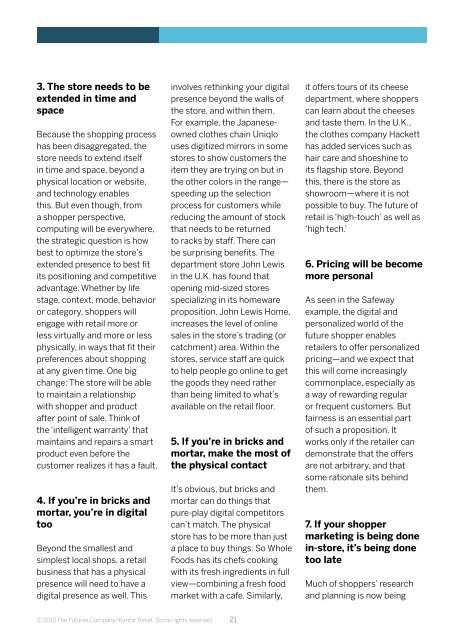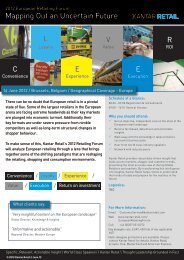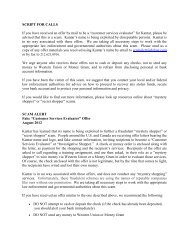The Future Shopper March 2013.pdf - Kantar Retail
The Future Shopper March 2013.pdf - Kantar Retail
The Future Shopper March 2013.pdf - Kantar Retail
Create successful ePaper yourself
Turn your PDF publications into a flip-book with our unique Google optimized e-Paper software.
3. <strong>The</strong> store needs to be<br />
extended in time and<br />
space<br />
Because the shopping process<br />
has been disaggregated, the<br />
store needs to extend itself<br />
in time and space, beyond a<br />
physical location or website,<br />
and technology enables<br />
this. But even though, from<br />
a shopper perspective,<br />
computing will be everywhere,<br />
the strategic question is how<br />
best to optimize the store’s<br />
extended presence to best fit<br />
its positioning and competitive<br />
advantage. Whether by life<br />
stage, context, mode, behavior<br />
or category, shoppers will<br />
engage with retail more or<br />
less virtually and more or less<br />
physically, in ways that fit their<br />
preferences about shopping<br />
at any given time. One big<br />
change: <strong>The</strong> store will be able<br />
to maintain a relationship<br />
with shopper and product<br />
after point of sale. Think of<br />
the ‘intelligent warranty’ that<br />
maintains and repairs a smart<br />
product even before the<br />
customer realizes it has a fault.<br />
4. If you’re in bricks and<br />
mortar, you’re in digital<br />
too<br />
Beyond the smallest and<br />
simplest local shops, a retail<br />
business that has a physical<br />
presence will need to have a<br />
digital presence as well. This<br />
involves rethinking your digital<br />
presence beyond the walls of<br />
the store, and within them.<br />
For example, the Japaneseowned<br />
clothes chain Uniqlo<br />
uses digitized mirrors in some<br />
stores to show customers the<br />
item they are trying on but in<br />
the other colors in the range—<br />
speeding up the selection<br />
process for customers while<br />
reducing the amount of stock<br />
that needs to be returned<br />
to racks by staff. <strong>The</strong>re can<br />
be surprising benefits. <strong>The</strong><br />
department store John Lewis<br />
in the U.K. has found that<br />
opening mid-sized stores<br />
specializing in its homeware<br />
proposition, John Lewis Home,<br />
increases the level of online<br />
sales in the store’s trading (or<br />
catchment) area. Within the<br />
stores, service staff are quick<br />
to help people go online to get<br />
the goods they need rather<br />
than being limited to what’s<br />
available on the retail floor.<br />
5. If you’re in bricks and<br />
mortar, make the most of<br />
the physical contact<br />
It’s obvious, but bricks and<br />
mortar can do things that<br />
pure-play digital competitors<br />
can’t match. <strong>The</strong> physical<br />
store has to be more than just<br />
a place to buy things. So Whole<br />
Foods has its chefs cooking<br />
with its fresh ingredients in full<br />
view—combining a fresh food<br />
market with a cafe. Similarly,<br />
it offers tours of its cheese<br />
department, where shoppers<br />
can learn about the cheeses<br />
and taste them. In the U.K.,<br />
the clothes company Hackett<br />
has added services such as<br />
hair care and shoeshine to<br />
its flagship store. Beyond<br />
this, there is the store as<br />
showroom—where it is not<br />
possible to buy. <strong>The</strong> future of<br />
retail is ‘high-touch’ as well as<br />
‘high tech.’<br />
6. Pricing will be become<br />
more personal<br />
As seen in the Safeway<br />
example, the digital and<br />
personalized world of the<br />
future shopper enables<br />
retailers to offer personalized<br />
pricing—and we expect that<br />
this will come increasingly<br />
commonplace, especially as<br />
a way of rewarding regular<br />
or frequent customers. But<br />
fairness is an essential part<br />
of such a proposition. It<br />
works only if the retailer can<br />
demonstrate that the offers<br />
are not arbitrary, and that<br />
some rationale sits behind<br />
them.<br />
7. If your shopper<br />
marketing is being done<br />
in-store, it’s being done<br />
too late<br />
Much of shoppers’ research<br />
and planning is now being<br />
© 2013 <strong>The</strong> <strong>Future</strong>s Company/<strong>Kantar</strong> <strong>Retail</strong>. Some rights reserved. 21












